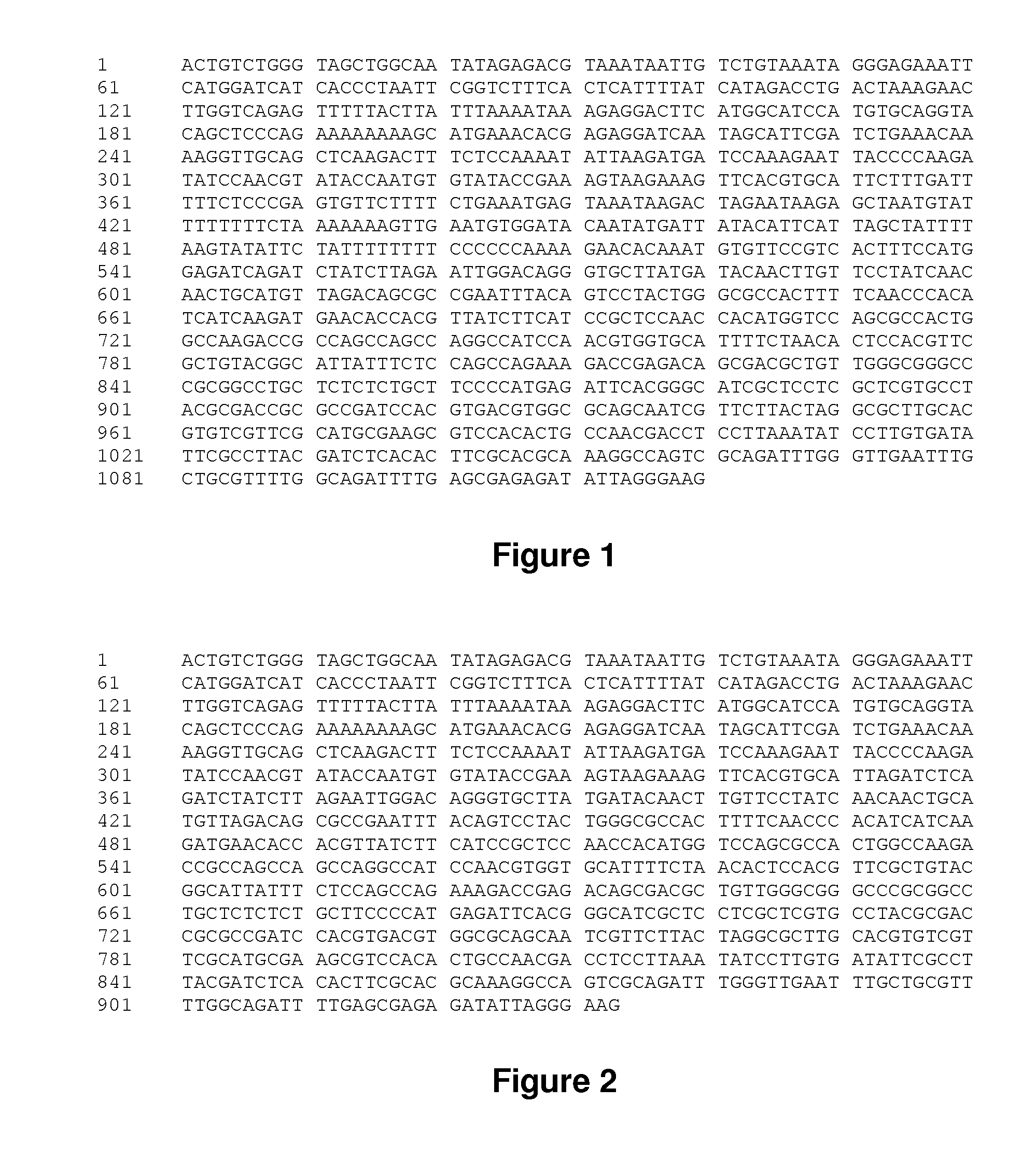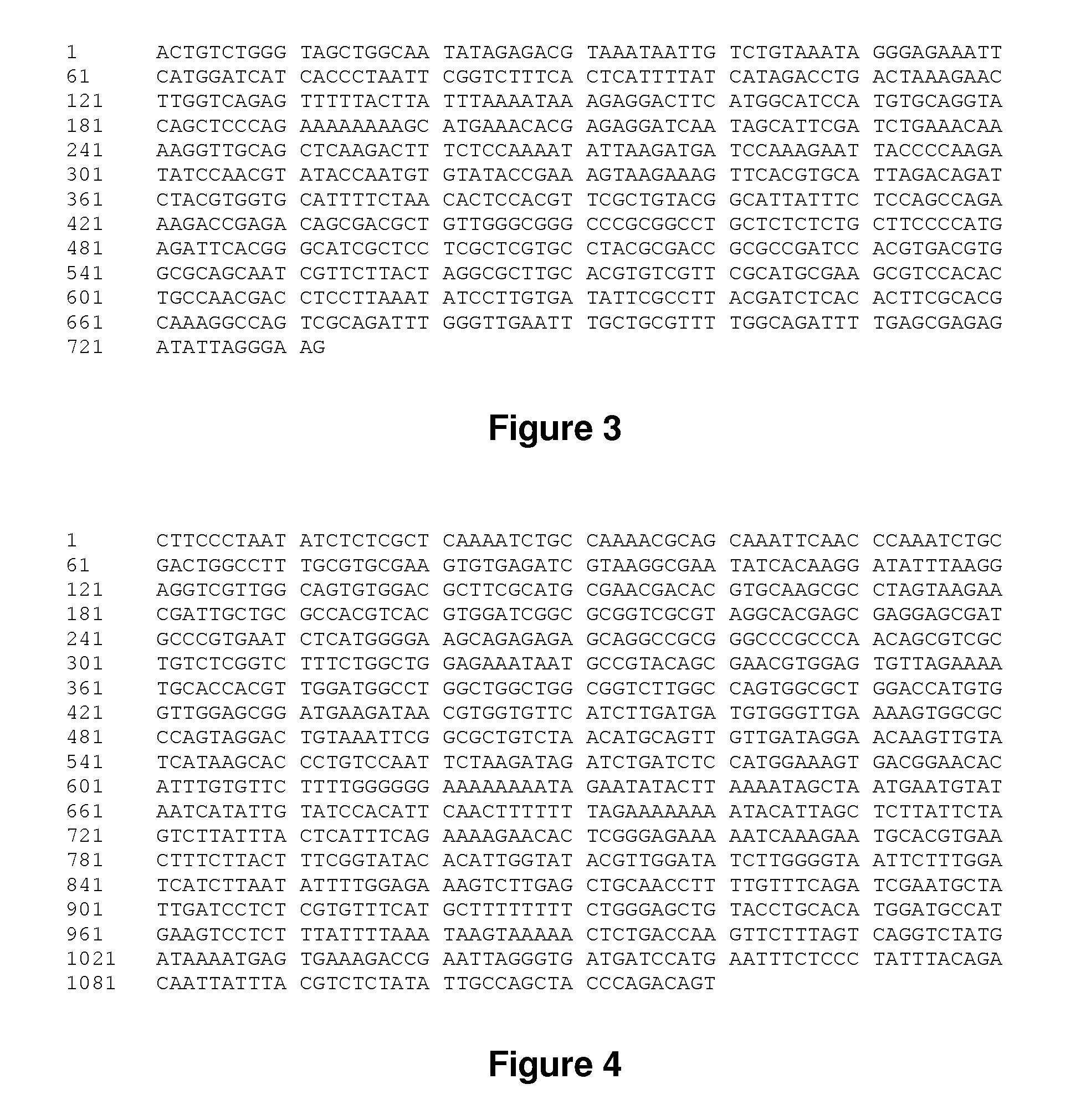Stress inducible derivative promoter
- Summary
- Abstract
- Description
- Claims
- Application Information
AI Technical Summary
Benefits of technology
Problems solved by technology
Method used
Image
Examples
example 1
[0067]Mutagenesis of XvPSap1
[0068]Internal deletions were performed on the XvPSap1 (SEQ ID NO:9) promoter in the recombinant pBluescript::XvPSap1 plasmid to generate four shortened promoter fragments designated XvPSap1D (SEQ ID NO:1), XvPSap1E (SEQ ID NO:2), XvPSap1F (SEQ ID NO:7) and XvPSap1G (SEQ ID NO:3). Two forward primers (Primer A (SEQ ID NO:12) and Primer B (SEQ ID NO:13)) and two reverse primers (Primer C (SEQ ID NO:14) and Primer D (SEQ ID NO:15)) were designed (Table 1). Primers A and B bind to the 3′-end of XvPSap1 for amplification of 378 bp and 575 bp fragments of the XvPSap1 promoter, respectively (FIG. 10A). Similarly, primers C and D bind to the 5′-end of XvPSap1 for amplification of 546 bp and 358 bp fragments of the XvPSap1 promoter, respectively (FIG. 10A). The mutagenesis strategy involved the use of combinations of the respective forward and reverse primers to generate the four putative promoters in linearised pBluescript vector (FIG. 10B). Primer set B and C g...
example 2
[0077]Generation of pBluescript::Promoter Fragment::luc::NosT
[0078]Endonuclease digestion of the pBluescript vector containing the promoter fragments with EcoRI and BamHI allowed for cleavage of the promoter constructs from the pBluescript plasmid. Similarly, EcoRI and BamHI double digestion of pBluescript::XvPSap1::luc::NosT (FIG. 12) allowed for removal of the original XvPSap1 promoter, resulting in linearised pBluescript::luc::NosT with EcoRI and BamHI overhangs.
[0079]Three micrograms of each recombinant pBluescript plasmid was digested in a total volume of 60 μl using EcoRI and BamHI (FastDigest, Fermentas). The reaction mixture contained 6 μl of 10× FastDigest buffer, 3 units FastDigest EcoRI and 3 units FastDigest BamHI. Similarly, 4 μg of pBluescript::XvPSap1::luc::NosT was digested in a total volume of 80 μl using EcoRI and BamHI (FastDigest, Fermentas). The reaction mixture contained 8 μl of 10× FastDigest buffer, 4 units FastDigest EcoRI and 4 units FastDigest BamHI. The d...
example 3
[0088]Generation of Binary Vector Constructs
[0089]Digestion of pBluescript::promoter_fragment::luc::NosT constructs with EcoRI and HindIII allowed for cleavage of each shortened promoter cassette from the recombinant plasmid. Similarly, the EcoRI and HindIII restriction double digestion of pTF101.1 (SEQ ID NO:29) resulted in linearised pTF101.1 with cohesive EcoRI and HindIII overhangs. pTF101.1 is a binary vector used in plant transformation protocols.
[0090]Initially, 3 μg of each recombinant plasmid was digested in a total volume of 20 μl using PvuII (Fermentas). The reaction mixture, containing 2 μl of 10× Buffer G and 1 unit PvuII, was incubated for 1 h at 37° C. The PvuII digest was necessary to differentiate between the promoter cassettes and the pBluescript vector due to their similar size (approximately 3 kb). PvuII cleaves pBluescript to yield two fragments of approximately 2.4 kb and a single 0.5 kb fragment. PvuII does not cleave the promoter constructs. Thus, it was poss...
PUM
| Property | Measurement | Unit |
|---|---|---|
| Fraction | aaaaa | aaaaa |
| Stress optical coefficient | aaaaa | aaaaa |
Abstract
Description
Claims
Application Information
 Login to view more
Login to view more - R&D Engineer
- R&D Manager
- IP Professional
- Industry Leading Data Capabilities
- Powerful AI technology
- Patent DNA Extraction
Browse by: Latest US Patents, China's latest patents, Technical Efficacy Thesaurus, Application Domain, Technology Topic.
© 2024 PatSnap. All rights reserved.Legal|Privacy policy|Modern Slavery Act Transparency Statement|Sitemap



